 Technology
Technology  Technology
Technology  Humans
Humans 10 Everyday Human Behaviors That Are Actually Survival Instincts
 Animals
Animals 10 Animals That Humiliated and Harmed Historical Leaders
 History
History 10 Most Influential Protests in Modern History
 Creepy
Creepy 10 More Representations of Death from Myth, Legend, and Folktale
 Technology
Technology 10 Scientific Breakthroughs of 2025 That’ll Change Everything
 Our World
Our World 10 Ways Icelandic Culture Makes Other Countries Look Boring
 Misconceptions
Misconceptions 10 Common Misconceptions About the Victorian Era
 Mysteries
Mysteries 10 Strange Unexplained Mysteries of 2025
 Miscellaneous
Miscellaneous 10 of History’s Most Bell-Ringing Finishing Moves
 Technology
Technology Top 10 Everyday Tech Buzzwords That Hide a Darker Past
 Humans
Humans 10 Everyday Human Behaviors That Are Actually Survival Instincts
 Animals
Animals 10 Animals That Humiliated and Harmed Historical Leaders
Who's Behind Listverse?

Jamie Frater
Head Editor
Jamie founded Listverse due to an insatiable desire to share fascinating, obscure, and bizarre facts. He has been a guest speaker on numerous national radio and television stations and is a five time published author.
More About Us History
History 10 Most Influential Protests in Modern History
 Creepy
Creepy 10 More Representations of Death from Myth, Legend, and Folktale
 Technology
Technology 10 Scientific Breakthroughs of 2025 That’ll Change Everything
 Our World
Our World 10 Ways Icelandic Culture Makes Other Countries Look Boring
 Misconceptions
Misconceptions 10 Common Misconceptions About the Victorian Era
 Mysteries
Mysteries 10 Strange Unexplained Mysteries of 2025
 Miscellaneous
Miscellaneous 10 of History’s Most Bell-Ringing Finishing Moves
10 Life-Changing Inventions That Were Discovered By Accident
Have you ever wondered how somebody came up with an idea? For example, how did somebody ever think of making an X-ray machine or a microwave oven? By accident, that’s how!
Many of mankind’s most useful devices and contraptions were invented completely by mistake. For centuries, scientists have been tasked with finding the solution to a particular problem, only to discover something totally different. Here is a list of some of the most important and useful inventions that were discovered or invented by mistake.
10 Fireworks

Some 2,000 years ago in a Chinese kitchen, a cook made one of the oldest accidental discoveries known to man when he mixed sulfur, saltpeter (potassium nitrile), and charcoal over a fire. Let’s just say combustion ensued. What the cook was thinking, or whether or not he made it to work the next day, is not known, but the he’d just made a discovery that would change the history of the world forever. The ancient Chinese called it “fire chemical” and quickly learned that when they compressed the concoction, such as inside a piece of bamboo, it exploded. Thus, the firecracker was born.
Firecrackers became very common and were used during important events, such as weddings and funerals, all over the country. The Chinese believed that the retort, or bang, from the firecracker, kept evil spirits away from the ceremony. They would eventually learn through experimentation that they could produce thrust that would propel the bamboo container through the air, instead of exploding instantly, and soon, the solid-fuel rocket was invented. They put the two together, firecrackers and rockets, and fireworks were born.
Historians tell us that Marco Polo brought fireworks from China and introduced them to people in regions of the Middle East. From there, they made it to England, where interest in fireworks was strictly to weaponize them. Although the English are credited for devising the standard recipe for black powder still in use today, it was the Italians who turned the making of fireworks into an art form, with the use of multiple colors and choreographed firework displays. Needless to say, the Italians’ celebrations got louder and more colorful as they experimented with different chemical combinations that would produce different colors when burned. However, none of it would have been possible if not for the accidental discovery of “fire chemical” by a 2,000-year-old Chinese cook.[1] (What the heck was he making, anyway?)
9 Laughing Gas (Nitrous Oxide)
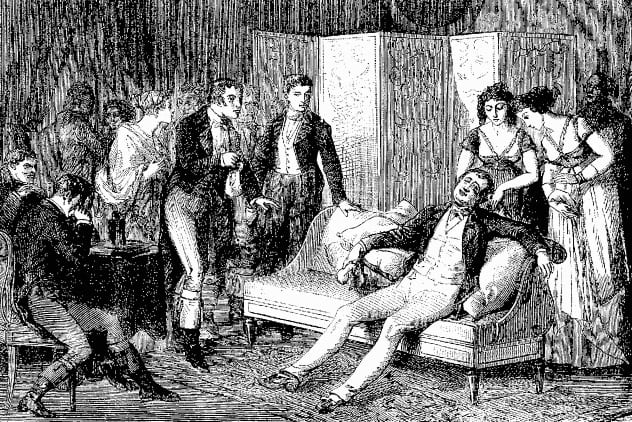
In 1799, Humphry Davy, a young English inventor and chemist who would eventually be elected president of the Royal Society in London, decided to use himself as a Guinea pig to find out the effects of inhaling artificially produced gases, all in the name of science. Along with an assistant, Dr. Kinglake, they discovered that heat-treating ammonium nitrate crystals produced a gas that they could collect in special oil-treated silk bags. They then could run the gas through water vapors, which would purify it.
After attaching a makeshift mouthpiece, Humphry inhaled a bag of the gas and was euphorically amazed and more than pleasantly surprised with the results. He had discovered nitrous oxide, or laughing gas, and probably the very origin of the saying, “They were gassed!” Humphry reported that he felt “giddiness, flushed cheeks, intense pleasure, and sublime emotion connected with highly vivid ideas.” He soon started experimenting with the gas more and more until he was inhaling laughing gas away from the lab and after drinking alcohol when at home. Although he did keep detailed notes on his observations while breathing laughing gas, the amount he was consuming rose dramatically.
Davy would let his patients and colleagues try the gas, as long as they also recorded their experiences for science.[2] Some of them were quite famous, such as the heir to the famous Wedgwood pottery company and well-known poets Samuel Taylor Coleridge and Robert Southey. Humphry went so far as to construct an airtight box which subjects would get into and breathe pure nitrous oxide. In 1800, Davy wrote Researches, Chemical and Philosophical, chiefly concerning Nitrous Oxide and its Respiration, which are 80 very entertaining pages of his experiences while experimenting with laughing gas.
8 Saccharin

Other than lead acetate, which is a known toxin, saccharin is the first artificial sweetener to inexpensively replace cane sugar, and it was discovered completely by accident. Sometime in late 1878 or early 1879, Professor Ira Remsen was running a small laboratory at John Hopkins University in Baltimore, Maryland, when he was approached by an import firm, H.W. Perot, to do some work regarding sugar. The firm wanted Constantin Fahlberg, an expert on the sweet stuff, to use Remsen’s lab to test the purity of a shipment of it.
After successfully completing the tests, Fahlberg stayed on working for the professor on various projects. One day, while eating his dinner, Fahlberg discovered that his roll tasted unusually sweet and decided to find out why. After deducing that the bread hadn’t been sweetened by the baker, the proverbial light bulb lit up, and he assumed that he must have gotten a chemical on his hands while working at the lab, and that substance had been transferred to his roll, making it taste sweet. Since he felt no adverse reactions to this unknown chemical, he decided to find out what it was.
Fahlberg couldn’t remember exactly what substance he’d brought home on his hands, so he simply taste-tested every chemical he had at his workstation the day before, and voila—he found it! He discovered that he had filled a beaker with phosphorus chloride, ammonia, and sulfobenzoic acid, which, in turn, created benzoic sulfimide, which was a compound he knew of but never had any reason to eat. He had discovered saccharin, which really became popular during the sugar shortages of World War I.
Contrary to popular belief, saccharin is perfectly safe to consume, and there are studies on record to prove it. In fact, as recently as 2010, the EPA publicly stated that “saccharin is no longer considered a potential hazard to human health.”[3]
7 X-Rays
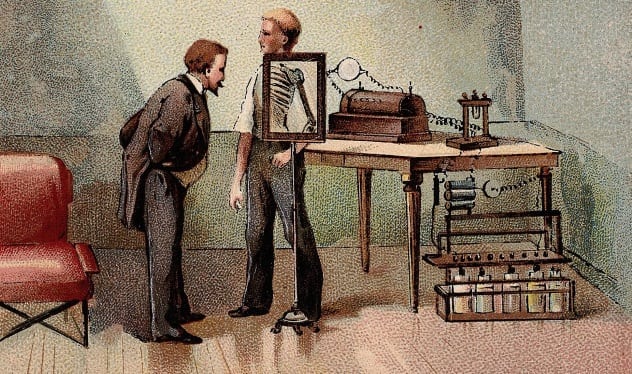
On November 8, 1895, Wilhelm Conrad Rontgen, a German physicist, was working in his lab running tests on cathode rays when, out of his peripheral vision, he spotted a strange glow on a screen that had earlier been treated with chemicals. Wilhelm had been the first person in history to observe X-rays, which is what he dubbed them due to their unknown and mysterious properties.
X-rays are waves of electromagnetic energy that are similar to light, except that they run in wavelengths around 1,000 times shorter, allowing them to pass through soft substances such as skin and muscle but not harder ones such as bone or metal. They would revolutionize the field of diagnostic medicine by affording physicians a non-intrusive means to see inside the human body without surgery. It wasn’t long before this important diagnostic tool made headlines around the globe when it was used on the battlefield during the Balkan War to locate bullets and diagnose broken limbs.
Although the scientists of the day took no time at all in finding the benefits of X-rays, it took much longer for them to discover the harmful qualities of these magical rays. It was believed that X-rays passed through the human body harmlessly just as light does, but after several years, reports of strange skin damage and burns started piling up. In 1904 Clarence Dally, a scientist working with X-rays for Thomas Edison, died of skin cancer from overexposure to X-rays. This caused some scientists working in the field to start being more careful, but it still took quite some time before the harmful effects of radiation would really sink in.
For example, starting in the 1930s, shoe stores in the United States used fluoroscopes to draw people in. These machines would amaze customers by letting them actually see the bones in their feet, and it wasn’t until the 1950s that the danger of this novelty item was realized, and they were banned from use completely. Today, X-rays are still widely used in the fields of medicine, security, and material analysis.[4]
6 Silly Putty
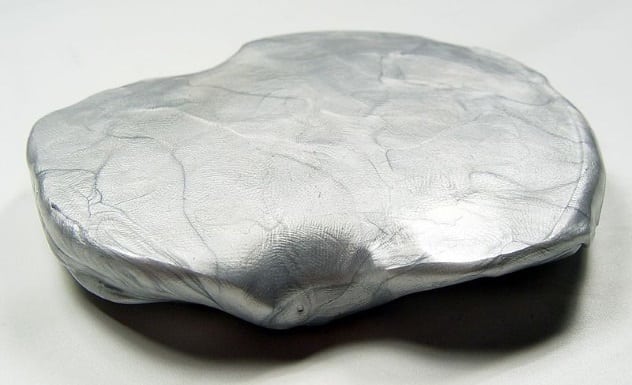
With no moving parts or electronics to fail, Silly Putty remains one of the most prolific toys ever produced. In its first five years, over 32 million units were bought worldwide. Today, it is guesstimated that almost a third of a billion have been sold around the globe! This was obviously a good thing for its inventor; General Electric (GE) engineer Dr. James Wright, who discovered the gooey stuff in 1943.
During the height of World War II, the good doctor had been tasked by his employers to concoct a synthetic form of rubber. But instead of delivering misery in the form of war machines rolling on synthetic rubber tires, he brought joy and happiness in the form of a cheap and simple way to entertain millions of all ages. While trying different chemical combinations to produce synthetic rubber, Dr. Wright mixed silicone oil and boric acid together, and he managed to invent a sticky mass of goop that would eventually be dubbed “Silly Putty.” (Note that Earl Warrick has also been credited with Silly Putty’s invention.)
The stuff did have a few properties that were rather unusual. For instance, it would keep its ability to bounce even better than rubber throughout a wide range of temperatures, yet when hit with a hammer, it shattered. Scientists at GE experimented with the stuff but couldn’t find any practical use for it. Not wanting to give up on the material, they sent samples to engineers around the globe in the hopes that someone might find a viable use for it.
There are multiple versions of what happened next, but the following is considered to be the most credible: Fittingly, all it took was a party to get Silly Putty going. It was a good thing for advertising agent Paul Hodgson, too. He was trying to get a toy catalog together and attended a party where he watched adults having a blast with a ball of some kind of putty. They were having so much fun sticking it to things and stretching it around the room that he decided to include the stuff in his catalog as “Nutty Putty.” Hodgson was surprised when it outsold everything in the catalog, so he decided to buy more. After finding out where it came from, he bought some from GE, filled a bunch of plastic eggs with an ounce of the stuff, renamed it “Silly Putty,” and sold over 250,000 of them in three days, at $1 each!
Over the years, fans have found many uses for Silly Putty, including squeezing it for exercise, fixing a wobbly table leg, picking lint off things, and lifting pictures off comic books and newspapers. Silly Putty made it to space in 1968 with the astronauts of Apollo 8, who used it to hold their tools in place during the mission.[5]
5 Microwave Ovens
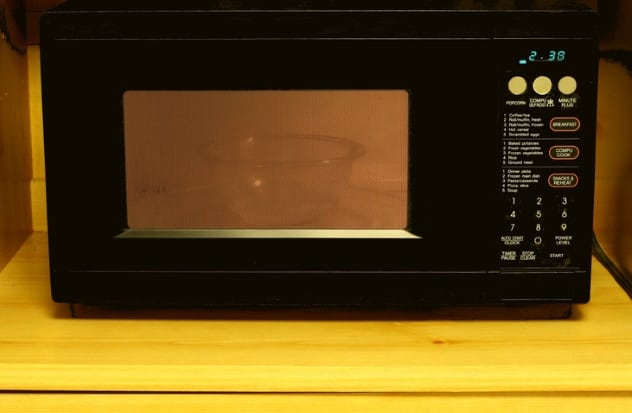
You push “2” on the keypad. A box lights up, and you see a plate rotating with a small, brown packet on it. Soon, a machine-gun rattle fills your kitchen air with the familiar, tantalizing odor of your favorite buttery snack. You have in front of you not only steaming hot and buttery popcorn but one of most prolific machines ever invented in history, and it was discovered by accident! It is the microwave.
Today, there is one of these miraculous contraptions in over 90 percent of American households, providing hundreds of millions with any food from A to Z, and everything in between, in seconds. In 1946, an engineer working for Raytheon named Percy Spencer was working with a magnetron, the main component of a radar system, when he found that a candy bar he was carrying in his shirt pocket had melted into a gooey mess while he was in close proximity to the device. His interest piqued, he placed an egg in the path of the magnetron’s rays and got a face full of egg for his trouble. He then got the idea to put some corn kernels on a plate, and he got them to pop all over the lab!
The rest, as they say, was history. Percy Spencer is also credited with the invention of the proximity fuse, which allows bombs to explode above their targets for a much better effect.[6]
4 Scotchgard
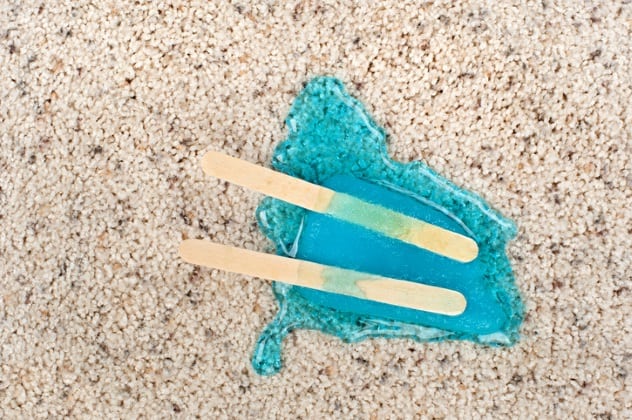
Fluorochemical technology, which involves products made from chemical compounds containing fluorine, is 3M’s bread and butter, so to speak. They have been global leaders in the industry for well over half a century, yet there was a time when their scientists were greatly challenged by the task of creating useful products using this technology. A young chemist named Patsy Sherman accepted that challenge when she was hired by 3M in 1952 and soon agreed to meet it in 1953. Sherman was then given the assignment to come up with a rubber-like material that would resist jet fuel and, as so often happens, discovered something totally different instead.
It started with an accident when one of her assistants spilled some of a compound they’d been experimenting with on her new sneakers. She was really irritated by the fact that she couldn’t get the stuff off of them no matter what kind of solvent she tried. This intrigued Sherman, who was excited by the tenacity of the experimental product, so she joined forces with Sam Smith, another 3M chemist, in an effort to develop a badly needed and inexpensive fluorochemical waterproofing agent for clothing, something unimaginable at the time.
After a few years spent refining their compound, the team of Sherman and Smith unveiled their brand-new product to the world, and in 1956, the brand name “Scotchgard” was born. 3M had stumbled onto their first big seller. When asked about the company’s good fortune for constantly coming up with innovative and successful products in this manner, Richard Carlton, a 3M executive, astutely replied, “You can’t stumble if you’re not in motion.”[7]
3 Pacemakers

It was 1956. Wilson Greatbatch was working on a device to monitor and record the sounds of the human heart when he inserted a transistor into his device that was 100 times as powerful as he would normally use. His mistake caused the instrument to create electrical impulses that were perfectly emulating the beat of the heart. So, instead of ruining the thing, which could easily have happened, the device wasn’t monitoring the heartbeat; it was creating one! He was amazed when he quickly realized that his invention could be used as an internal pacemaker, an instrument which, at the time, had to be worn like a necklace, with the thing shocking the patient to keep their heart beating.
The very first pacemakers looked like a television that the patient was tethered to, and since battery power was insufficient at the time, they had to be plugged in as well. A patient who needed a pacemaker then was much like a person on dialysis; they couldn’t leave the machine, and they couldn’t carry it around. An internal pacemaker would allow millions of these people to live completely normal lives. So, a bit bigger than a hockey puck, Greatbatch’s first prototype was implanted into a dog in 1958 and controlled its heartbeat successfully and without difficulty. The first human patient to receive one was a 77-year-old man who lived 18 months, while a young recipient lived 30 years with his.
They did have their problems, though. Body fluids would permeate the device, ruining the circuitry, and batteries would last only about two years, so Greatbatch started looking for better ways to power them. In 1970, he started his own company, Greatbatch Inc., and developed lithium batteries that lasted ten years and would eventually be used in over 90 percent of pacemakers on the planet. The brilliant inventor ended up with 350 patents in his name and was inducted into the National Inventor’s Hall of Fame in 1986. Today, over three million people benefit from Greatbatch’s inventions, and 600,000 of his pacemakers are implanted every year. Wilson Greatbatch passed away in 2011.[8]
2 Post-It Notes

In 1968, a scientist working for the Minnesota Mining and Manufacturing Corporation (also known as 3M) named Spencer Silver was given the job of inventing a super adhesive designed exclusively to be used in the aerospace industry, a very tough industry to design for. His initial attempt was a flop. He was looking for strength but got something strong enough to maybe hold a sheet of paper to a bulletin board, giving them the idea to fashion some notepad prototypes, even though they didn’t have much faith in the concept. Art Fry, another employee of 3M, had the idea to use one of these prototypes as bookmarks in his choir hymn book because he kept losing his place while singing. With this practical use, he realized that the prototype notes worked perfectly by sticking really well while leaving no glue and not damaging the pages.
Silver, Fry, and several others who worked on perfecting the notes had mistakenly invented an entire brand-new hit product line. It was tough going at first, but after four failed marketing attempts in as many big cities, 3M managed to get free samples into the hands of people in Boise, Idaho, where “Post-its” finally took off. It had been 12 years, but it was worth the struggle in the end.[9]
An interesting story about Post-it notes surrounds the familiar yellow color they chose to initially market them in. The official story is that the yellow “made a good emotional connection with users” and that it also “contrasts well when stuck on white paper.” But according to an insider, the lab next door to the Post-it team’s had a surplus of scrap yellow paper, and that’s how the color was decided. In fact, after their neighbors ran out of it, they went out and bought more. Spencer Silver, who started his education in a one-room schoolhouse, is the owner of 22 patents, including the patent for a “low-tack, reusable, pressure sensitive adhesive” or, more commonly, “stickless glue.”
1 Self-Igniting Matches
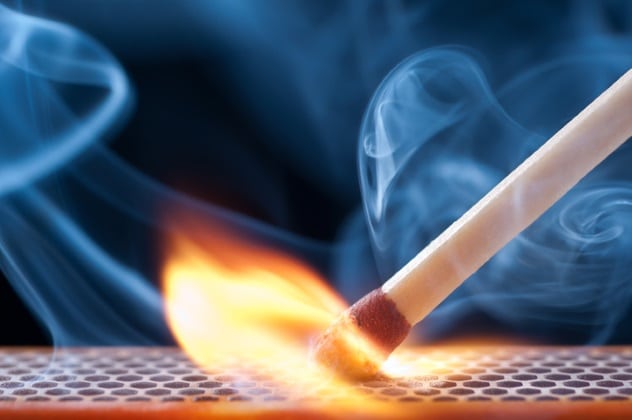
Humans have had fire for eons, and we’ve always looked for easy ways to start fires. The modern-day match transformed our world and enriched our way of life in ways their inventors could never have imagined, but early matches weren’t strikable or self-igniting and needed some other means to light. For example, early Chinese matches were coated with sulfur that burned very bright and were used to enlarge an existing fire quickly, but they never evolved beyond that ability.
A Parisian named Jean Chancel opened the door to self-igniting matches in 1805 when he mixed sugar, rubber, potassium chlorate, and sulfur together and coated wooden sticks with the concoction. He then would dip the sticks into a sulfuric acid solution to get them to light. The problem with this invention was the toxic and volatile clouds of chlorine dioxide gas they produced. These clouds were explosive, making them rather dangerous.
The real breakthrough came in 1826, when an English chemist named John Walker invented the first “friction match”—you guessed it—by accident. While working in his lab, Walker noticed that a glob of chemicals he’d been working with earlier had dried and formed a lump on the end of his stir stick. Not wanting to mix the chemicals into his present experiment, he started scraping the stuff off the implement and was both startled and pleased when it burst into flame! Walker used a sulfur-based compound on the matches’ heads and rough paper coated with phosphorus to strike them with. The user would fold the paper over the match and pull it through while applying a bit of pressure to light it. He sold quite a few of these fire sticks, but they had a problem: The sulfur burned so violently that it would burn through the stick, and the flaming head would come off, many times with undesirable results.[10]
Matches these days are made from a red phosphorus concoction, first employed by Johan Edvard Lundstrom, which is completely nontoxic. Safety matches, which are familiar to most today, were first produced and sold in the United States by the Diamond Match Company, which gave up their rights to patent them so that any company could produce and market safety matches.
I live in Northwestern Pennsylvania in the United States of America, in “one of the Original 13” I like to say, where I grew up with a fascination for collectibles like baseball cards, coins, stamps, and old bottles, just to name a few. Always a self-starter, I’ve taught myself many different things and have ended up with a large variety of skills and hobbies in both the old and new and have recently started putting them to use on the Internet. I have been writing in several capacities for decades.
Read about more ways we’ve bumbled into advancement on 10 Fascinating Experiments That Happened By Accident and Top 10 Accidental Discoveries.








